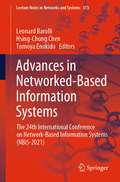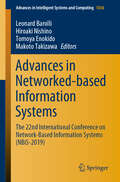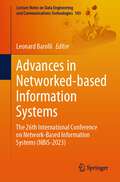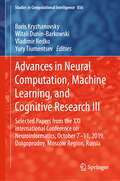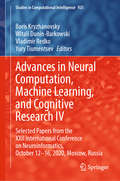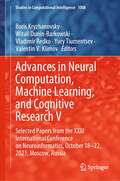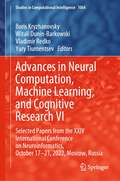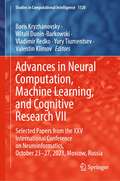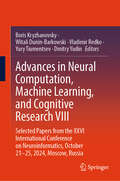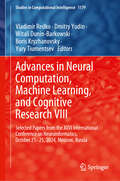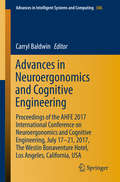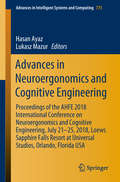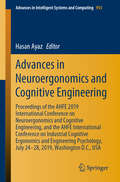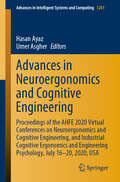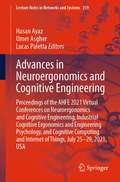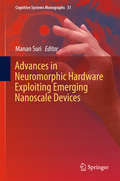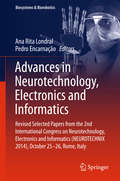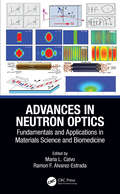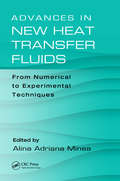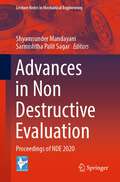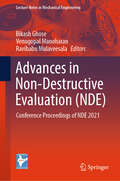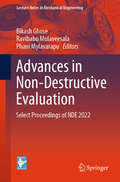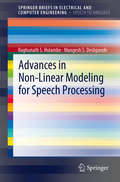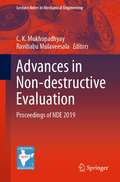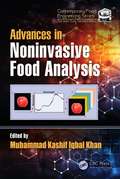- Table View
- List View
Advances in Networked-Based Information Systems: The 24th International Conference on Network-Based Information Systems (NBiS-2021) (Lecture Notes in Networks and Systems #313)
by Leonard Barolli Tomoya Enokido Hsing-Chung ChenThis book provides the latest research findings, innovative research results, methods and development techniques from both theoretical and practical perspectives related to the emerging areas of information networking and their applications. The networks and information systems of today are evolving rapidly. There are new trends and applications in information networking such as wireless sensor networks, ad hoc networks, peer-to-peer systems, vehicular networks, opportunistic networks, grid and cloud computing, pervasive and ubiquitous computing, multimedia systems, security, multi-agent systems, high-speed networks, and web-based systems. These kinds of networks need to manage the increasing number of users, provide support for different services, guarantee the QoS, and optimize the network resources. For these networks, there are many research issues and challenges that should be considered and find solutions.
Advances in Networked-based Information Systems: The 22nd International Conference on Network-Based Information Systems (NBiS-2019) (Advances in Intelligent Systems and Computing #1036)
by Makoto Takizawa Leonard Barolli Tomoya Enokido Hiroaki NishinoThis book focuses on the emerging areas of information networking and its applications, presenting the latest innovative research and development techniques from both theoretical and practical perspectives. Today’s networks and information systems are evolving rapidly, and there are new trends and applications in information networking, such as wireless sensor networks, ad hoc networks, peer-to-peer systems, vehicular networks, opportunistic networks, grid and cloud computing, pervasive and ubiquitous computing, multimedia systems, security, multi-agent systems, high-speed networks, and web-based systems. However, since these networks need to be capable of managing the increasing number of users, provide support for different services, guarantee the QoS, and optimize the network resources, a number of research issues and challenges have to be considered in order to provide solutions.
Advances in Networked-based Information Systems: The 26th International Conference on Network-Based Information Systems (NBiS-2023) (Lecture Notes on Data Engineering and Communications Technologies #183)
by Leonard BarolliThe networks and information systems of today are evolving rapidly. There are new trends and applications in information networking such as wireless sensor networks, ad hoc networks, peer-to-peer systems, vehicular networks, opportunistic networks, grid and cloud computing, pervasive and ubiquitous computing, multimedia systems, security, multi-agent systems, high-speed networks, and web-based systems. These kinds of networks need to manage the increasing number of users, provide support for different services, guarantee the QoS, and optimize the network resources. For these networks, there are many research issues and challenges that should be considered and find solutions. The aim of the book is to provide latest research findings, innovative research results, methods, and development techniques from both theoretical and practical perspectives related to the emerging areas of information networking and their applications.
Advances in Neural Computation, Machine Learning, and Cognitive Research III: Selected Papers from the XXI International Conference on Neuroinformatics, October 7-11, 2019, Dolgoprudny, Moscow Region, Russia (Studies in Computational Intelligence #856)
by Boris Kryzhanovsky Witali Dunin-Barkowski Vladimir Redko Yury TiumentsevThis book describes new theories and applications of artificial neural networks, with a special focus on answering questions in neuroscience, biology and biophysics and cognitive research. It covers a wide range of methods and technologies, including deep neural networks, large scale neural models, brain computer interface, signal processing methods, as well as models of perception, studies on emotion recognition, self-organization and many more. The book includes both selected and invited papers presented at the XXI International Conference on Neuroinformatics, held on October 7-11, 2019, in Dolgoprudny, a town in Moscow region, Russia.
Advances in Neural Computation, Machine Learning, and Cognitive Research IV: Selected Papers from the XXII International Conference on Neuroinformatics, October 12-16, 2020, Moscow, Russia (Studies in Computational Intelligence #925)
by Boris Kryzhanovsky Witali Dunin-Barkowski Vladimir Redko Yury TiumentsevThis book describes new theories and applications of artificial neural networks, with a special focus on answering questions in neuroscience, biology and biophysics and cognitive research. It covers a wide range of methods and technologies, including deep neural networks, large scale neural models, brain computer interface, signal processing methods, as well as models of perception, studies on emotion recognition, self-organization and many more. The book includes both selected and invited papers presented at the XXII International Conference on Neuroinformatics, held on October 12-16, 2020, Moscow, Russia.
Advances in Neural Computation, Machine Learning, and Cognitive Research V: Selected Papers from the XXIII International Conference on Neuroinformatics, October 18-22, 2021, Moscow, Russia (Studies in Computational Intelligence #1008)
by Valentin V. Klimov Boris Kryzhanovsky Witali Dunin-Barkowski Vladimir Redko Yury TiumentsevThis book describes new theories and applications of artificial neural networks, with a special focus on answering questions in neuroscience, biology and biophysics and cognitive research. It covers a wide range of methods and technologies, including deep neural networks, large scale neural models, brain computer interface, signal processing methods, as well as models of perception, studies on emotion recognition, self-organization and many more. The book includes both selected and invited papers presented at the XXIII International Conference on Neuroinformatics, held on October 18-22, 2021, Moscow, Russia.
Advances in Neural Computation, Machine Learning, and Cognitive Research VI: Selected Papers from the XXIV International Conference on Neuroinformatics, October 17-21, 2022, Moscow, Russia (Studies in Computational Intelligence #1064)
by Boris Kryzhanovsky Witali Dunin-Barkowski Vladimir Redko Yury TiumentsevThis book describes new theories and applications of artificial neural networks, with a special focus on answering questions in neuroscience, biology and biophysics and cognitive research. It covers a wide range of methods and technologies, including deep neural networks, large-scale neural models, brain–computer interface, signal processing methods, as well as models of perception, studies on emotion recognition, self-organization and many more. The book includes both selected and invited papers presented at the XXIV International Conference on Neuroinformatics, held on October 17–21, 2022, in Moscow, Russia.
Advances in Neural Computation, Machine Learning, and Cognitive Research VII: Selected Papers from the XXV International Conference on Neuroinformatics, October 23-27, 2023, Moscow, Russia (Studies in Computational Intelligence #1120)
by Boris Kryzhanovsky Witali Dunin-Barkowski Vladimir Redko Yury Tiumentsev Valentin KlimovThis book describes new theories and applications of artificial neural networks, with a special focus on answering questions in neuroscience, biology and biophysics and cognitive research. It covers a wide range of methods and technologies, including deep neural networks, large-scale neural models, brain–computer interface, signal processing methods, as well as models of perception, studies on emotion recognition, self-organization and many more. The book includes both selected and invited papers presented at the XXV International Conference on Neuroinformatics, held on October 23-27, 2023, in Moscow, Russia.
Advances in Neural Computation, Machine Learning, and Cognitive Research VIII: Selected Papers from the XXVI International Conference on Neuroinformatics, October 21-25, 2024, Moscow, Russia
by Boris Kryzhanovsky Witali Dunin-Barkowski Vladimir Redko Yury Tiumentsev Dmitry YudinThis book describes new theories and applications of artificial neural networks, with a special focus on answering questions in neuroscience, biology and biophysics and cognitive research. It covers a wide range of methods and technologies, including deep neural networks, large-scale neural models, brain–computer interface, signal processing methods, as well as models of perception, studies on emotion recognition, self-organization and many more. The book includes both selected and invited papers presented at the XXVI International Conference on Neuroinformatics, held on October 21–25, 2024, in Moscow, Russia.
Advances in Neural Computation, Machine Learning, and Cognitive Research VIII: Selected Papers from the XXVI International Conference on Neuroinformatics, October 21-25, 2024, Moscow, Russia (Studies in Computational Intelligence #1179)
by Boris Kryzhanovsky Witali Dunin-Barkowski Vladimir Redko Yury Tiumentsev Dmitry YudinThis book describes new theories and applications of artificial neural networks, with a special focus on answering questions in neuroscience, biology and biophysics and cognitive research. It covers a wide range of methods and technologies, including deep neural networks, large-scale neural models, brain–computer interface, signal processing methods, as well as models of perception, studies on emotion recognition, self-organization and many more. The book includes both selected and invited papers presented at the XXVI International Conference on Neuroinformatics, held on October 21–25, 2024, in Moscow, Russia.
Advances in Neuroergonomics and Cognitive Engineering: Proceedings of the AHFE 2017 International Conference on Neuroergonomics and Cognitive Engineering, July 17–21, 2017, The Westin Bonaventure Hotel, Los Angeles, California, USA (Advances in Intelligent Systems and Computing #586)
by Carryl BaldwinThis book offers a broad perspective on the field of cognitive engineering and neuroergonomics, covering emerging practices and future trends toward the harmonious integration of human operators with computational systems. It reports on novel theoretical findings on mental workload and stress, activity theory, human reliability, error and risk, and neuroergonomic measures alike, together with a wealth of cutting-edge applications. Further, the book describes key advances in our understanding of cognitive processes, including mechanisms of perception, memory, reasoning, and motor response, with a special emphasis on their role in interactions between humans and other elements of computer-based systems. Based on the AHFE's main track on Neuroergonomics and Cognitive Engineering, held on July 17-21, 2017 in Los Angeles, California, USA, it provides readers with a comprehensive overview of the current challenges in cognitive computing and factors influencing human performance.
Advances in Neuroergonomics and Cognitive Engineering: Proceedings of the AHFE 2018 International Conference on Neuroergonomics and Cognitive Engineering, July 21–25, 2018, Loews Sapphire Falls Resort at Universal Studios, Orlando, Florida USA (Advances in Intelligent Systems and Computing #775)
by Hasan Ayaz Lukasz MazurThis book offers a broad perspective on the field of cognitive engineering and neuroergonomics, covering emerging practices and future trends toward the harmonious integration of human operators and computer systems. It presents novel theoretical findings on mental workload and stress, activity theory, human reliability, error and risk, and neuroergonomic measures alike, together with a wealth of cutting-edge applications. Further, the book describes key advances in our understanding of cognitive processes, including mechanisms of perception, memory, reasoning, and motor response, with a special emphasis on their role in interactions between humans and other elements of computer-based systems. Based on the AHFE 2018 affiliated conference on Neuroergonomics and Cognitive Engineering, held on July 21–25, 2018, in Orlando, Florida, USA, it provides readers with a comprehensive overview of the current challenges in cognitive computing and factors influencing human performance.
Advances in Neuroergonomics and Cognitive Engineering: Proceedings of the AHFE 2019 International Conference on Neuroergonomics and Cognitive Engineering, and the AHFE International Conference on Industrial Cognitive Ergonomics and Engineering Psychology, July 24-28, 2019, Washington D.C., USA (Advances in Intelligent Systems and Computing #953)
by Hasan AyazThis book offers a broad perspective on the field of cognitive engineering and neuroergonomics, covering emerging practices and future trends toward the harmonious integration of human operators and computer systems. It presents novel theoretical findings on mental workload and stress, activity theory, human reliability, error and risk, and neuroergonomic measures alike, together with a wealth of cutting-edge applications. Further, the book describes key advances in our understanding of cognitive processes, including mechanisms of perception, memory, reasoning, and motor response, with a special emphasis on their role in interactions between humans and other elements of computer-based systems. Based on the AHFE 2019 affiliated conference on Neuroergonomics and Cognitive Engineering, held on July 24-28, 2019, in Washington D.C., USA, it provides readers with a comprehensive overview of the current challenges in cognitive computing and factors influencing human performance.
Advances in Neuroergonomics and Cognitive Engineering: Proceedings of the AHFE 2020 Virtual Conferences on Neuroergonomics and Cognitive Engineering, and Industrial Cognitive Ergonomics and Engineering Psychology, July 16-20, 2020, USA (Advances in Intelligent Systems and Computing #1201)
by Hasan Ayaz Umer AsgherThis book offers broad overview of the field of cognitive engineering and neuroergonomics, covering emerging practices and future trends toward the harmonious integration of human operators and computer systems. It presents novel theoretical findings on mental workload and stress, activity theory, human reliability, error and risk, and a wealth of cutting-edge applications, such as strategies to make assistive technologies more user-oriented. Further, the book describes key advances in our understanding of cognitive processes, including mechanisms of perception, memory, reasoning, and motor response, with a particular focus on their role in interactions between humans and other elements of computer-based systems. Gathering the proceedings of the AHFE 2020 Virtual Conferences on Neuroergonomics and Cognitive Engineering, and Industrial Cognitive Ergonomics and Engineering Psychology, held on 16–20 July 2020, this book provides extensive and timely information for human–computer interaction researchers, human factors engineers and interaction designers, as well as decision-makers.
Advances in Neuroergonomics and Cognitive Engineering: Proceedings of the AHFE 2021 Virtual Conferences on Neuroergonomics and Cognitive Engineering, Industrial Cognitive Ergonomics and Engineering Psychology, and Cognitive Computing and Internet of Things, July 25-29, 2021, USA (Lecture Notes in Networks and Systems #259)
by Hasan Ayaz Umer Asgher Lucas PalettaThis book offers a broad overview of the field of cognitive engineering and neuroergonomics, covering emerging practices and future trends toward the harmonious integration of human operators and computational systems. It gathers both theoretical and practice-oriented studies on mental workload and stress, activity theory, human reliability, error and risk. It covers applications in various field, and corresponding strategies to make assistive technologies more user-oriented. Further, the book describes key advances in our understanding of cognitive processes, including mechanisms of perception, memory, reasoning, and motor response, with a particular focus on their role in interactions between humans and other elements of computer-based systems. Gathering the proceedings of the AHFE 2021 Conferences on Neuroergonomics and Cognitive Engineering, Industrial Cognitive Ergonomics and Engineering Psychology, and Cognitive Computing and Internet of Things, held virtually on July 25-29, 2021, from USA, this book offers extensive information and a thought-provoking guide for researchers and practitioners in cognitive engineering, neuroergonomics and their applications.
Advances in Neuromorphic Hardware Exploiting Emerging Nanoscale Devices (Cognitive Systems Monographs #31)
by Manan SuriThis book covers all major aspects of cutting-edge research in the field of neuromorphic hardware engineering involving emerging nanoscale devices. Special emphasis is given to leading works in hybrid low-power CMOS-Nanodevice design. The book offers readers a bidirectional (top-down and bottom-up) perspective on designing efficient bio-inspired hardware. At the nanodevice level, it focuses on various flavors of emerging resistive memory (RRAM) technology. At the algorithm level, it addresses optimized implementations of supervised and stochastic learning paradigms such as: spike-time-dependent plasticity (STDP), long-term potentiation (LTP), long-term depression (LTD), extreme learning machines (ELM) and early adoptions of restricted Boltzmann machines (RBM) to name a few. The contributions discuss system-level power/energy/parasitic trade-offs, and complex real-world applications. The book is suited for both advanced researchers and students interested in the field.
Advances in Neurotechnology, Electronics and Informatics: Revised Selected Papers from the 2nd International Congress on Neurotechnology, Electronics and Informatics (NEUROTECHNIX 2014), October 25-26, Rome, Italy (Biosystems & Biorobotics #12)
by Ana Rita Londral Pedro EncarnaçãoThis book is a timely report on current neurotechnology research. It presents a snapshot of the state of the art in the field, discusses current challenges and identifies new directions. The book includes a selection of extended and revised contributions presented at the 2nd International Congress on Neurotechnology, Electronics and Informatics (NEUROTECHNIX 2014), held October 25-26 in Rome, Italy. The chapters are varied: some report on novel theoretical methods for studying neuronal connectivity or neural system behaviour; others report on advanced technologies developed for similar purposes; while further contributions concern new engineering methods and technological tools supporting medical diagnosis and neurorehabilitation. All in all, this book provides graduate students, researchers and practitioners dealing with different aspects of neurotechnologies with a unified view of the field, thus fostering new ideas and research collaborations among groups from different disciplines.
Advances in Neutron Optics: Fundamentals and Applications in Materials Science and Biomedicine (Multidisciplinary and Applied Optics)
by Maria L. Calvo Ramon F. Alvarez-EstradaNeutron optics studies the interactions of a beam of slow neutrons with matter. This book updates various advances on neutron optics. There will be a focus on the very active topics of neutron imaging (NI) and neutron spin optics (NSO). The book will also present applications of neutron beams in biomedicine, such as Boron Neutron Capture Therapy (BNCT) and related techniques. Features: Discusses diffraction and interference of slow neutrons, including computational approaches Reviews neutron imaging (NI) and neutron spin optics (NSO) Treats two major sources of slow neutron beams: (1) fission reactions at nuclear reactors and (2) collisions in particle accelerators (small ones, spallation sources) of charged particle beams with targets of heavy atoms Selects subjects on fundamental quantum aspects of slow neutrons and on confined propagation and waveguiding thereof Updates slow neutron beams and BNCT
Advances in New Heat Transfer Fluids: From Numerical to Experimental Techniques (Heat Transfer)
by Alina Adriana MineaHeat transfer enhancement has seen rapid development and widespread use in both conventional and emerging technologies. Improvement of heat transfer fluids requires a balance between experimental and numerical work in nanofluids and new refrigerants. Recognizing the uncertainties in development of new heat transfer fluids, Advances in New Heat Transfer Fluids: From Numerical to Experimental Techniques contains both theoretical and practical coverage.
Advances in Non Destructive Evaluation: Proceedings of NDE 2020 (Lecture Notes in Mechanical Engineering)
by Shyamsunder Mandayam Sarmishtha Palit SagarThis book comprises the proceedings of the Conference and Exhibition on Non Destructive Evaluation (NDE 2020). The contents of the volume encompass a vast spectrum from Conventional to Advanced NDE including novel methods, instrumentation, sensors, procedures, and data analytics as applied to all industry segments for quality control, periodic maintenance, life estimation, structural integrity and related areas. This book will be a useful reference for students, researchers and practitioners.
Advances in Non-Destructive Evaluation: Conference Proceedings of NDE 2021 (Lecture Notes in Mechanical Engineering)
by Ravibabu Mulaveesala Bikash Ghose Venugopal ManoharanThis book comprises the proceedings of the Conference and Exhibition on Non-Destructive Evaluation (NDE 2021) organised by the Indian Society for Non-destructive Testing (ISNT). This book covers topics from wide domains from conventional to advanced NDE, including conventional and advanced NDE methods, drone-based inspections, thermal wave imaging, NDT data fusion, material characterization, waveguide sensors, inspections of civil structures, medical applications such as bone density and cancer diagnosis, periodic maintenance, life estimation, as well as structural integrity and related areas. This book serves as a useful reference for students, researchers, and practitioners alike.
Advances in Non-Destructive Evaluation: Select Proceedings of NDE 2022 (Lecture Notes in Mechanical Engineering)
by Ravibabu Mulaveesala Bikash Ghose Phani MylavarapuThis book comprises the proceedings of the Conference and Exhibition on Non-Destructive Evaluation (NDE 2022). The contents of the volume encompass a vast spectrum from conventional to advanced NDE including novel methods, and emerging NDE technologies. It covers topics from wide domains from conventional to advanced NDE methods which includes but not limited to drone-based inspections, thermal wave imaging, microwave NDE, shearography, Quantitative NDE using Digital Image Correlation, modeling and simulation, NDT data fusion, material characterization, waveguide sensors, inspections of civil structures, medical applications such as bone density and cancer diagnosis, signal and image processing, NDE sensors, instrumentation, software and systems, NDE 4.0 and robotics, automation, AI in NDE, functional and operational testing, NDE data analytics, reliability and safety assurance, periodic maintenance, life estimation, as well as structural integrity and related areas. This book serves as a useful reference for students, researchers, and practitioners working in the areas of non-destructive testing and evaluation.
Advances in Non-Linear Modeling for Speech Processing (SpringerBriefs in Speech Technology)
by Mangesh S. Deshpande Raghunath S. HolambeAdvances in Non-Linear Modeling for Speech Processing includes advanced topics in non-linear estimation and modeling techniques along with their applications to speaker recognition. Non-linear aeroacoustic modeling approach is used to estimate the important fine-structure speech events, which are not revealed by the short time Fourier transform (STFT). This aeroacostic modeling approach provides the impetus for the high resolution Teager energy operator (TEO). This operator is characterized by a time resolution that can track rapid signal energy changes within a glottal cycle. The cepstral features like linear prediction cepstral coefficients (LPCC) and mel frequency cepstral coefficients (MFCC) are computed from the magnitude spectrum of the speech frame and the phase spectra is neglected. To overcome the problem of neglecting the phase spectra, the speech production system can be represented as an amplitude modulation-frequency modulation (AM-FM) model. To demodulate the speech signal, to estimation the amplitude envelope and instantaneous frequency components, the energy separation algorithm (ESA) and the Hilbert transform demodulation (HTD) algorithm are discussed. Different features derived using above non-linear modeling techniques are used to develop a speaker identification system. Finally, it is shown that, the fusion of speech production and speech perception mechanisms can lead to a robust feature set.
Advances in Non-destructive Evaluation: Proceedings of NDE 2019 (Lecture Notes in Mechanical Engineering)
by C. K. Mukhopadhyay Ravibabu MulaveesalaThis book comprises the proceedings of the Conference and Exhibition on Non Destructive Evaluation, (NDE 2019). The contents of the book encompass a vast spectrum from Conventional to Advanced NDE including novel methods, instrumentation, sensors, procedures and data analytics as applied to all industry segments for quality control, periodic maintenance, life estimation, structural integrity and related areas. This book will be a useful reference for students, researchers and practitioners.
Advances in Noninvasive Food Analysis (Contemporary Food Engineering)
by Muhammad Kashif Iqbal KhanTo ensure food quality and safety food, professionals need a knowledge of food composition and characteristics. The analysis of food product is required for quality management throughout the developmental process including the raw materials and ingredients, but food analysis adds processing cost for food industry and consumes time for government agencies. Advances in Noninvasive Food Analysis explores the potential and recent advances in non-invasive food analysis techniques used to ensure food quality and safety. Such cost-reducing and time-saving non-destructive food analysis techniques covered include, Infrared, Raman Spectroscopy, and Nuclear Magnetic Resonance. The book also covers data processing and modelling. Features: Covers the advent of non-invasive, non-destructive methods of food analysis Presents such techniques as near and mid infrared, Raman Spectroscopy, and Nuclear Magnetic Resonance Describes the growing role of nanotechnology in non-invasive food analysis Includes image analysis and data processing and modelling required to sort out the data The prime for this book are food professionals working in industry, control authorities and research organizations that ensure food quality and safety as well as libraries of universities with substantial food science programs, food companies and food producers with research and development departments. Also available in the Contemporary Food Engineering series: Advances in Food Bioproducts, Fermentation Engineering and Bioprocessing Technologies , edited by Monica Lizeth Chavez Gonzalez, Nagamani Balagurusamy, Christobal N. Aguilar (ISBN 9781138544222) Advances in Vinegar Production, edited by Argyro Bekatorou (ISBN 9780815365990) Innovative Technologies in Seafood Processing, edited by Yesim Ozogul (ISBN 9780815366447)
